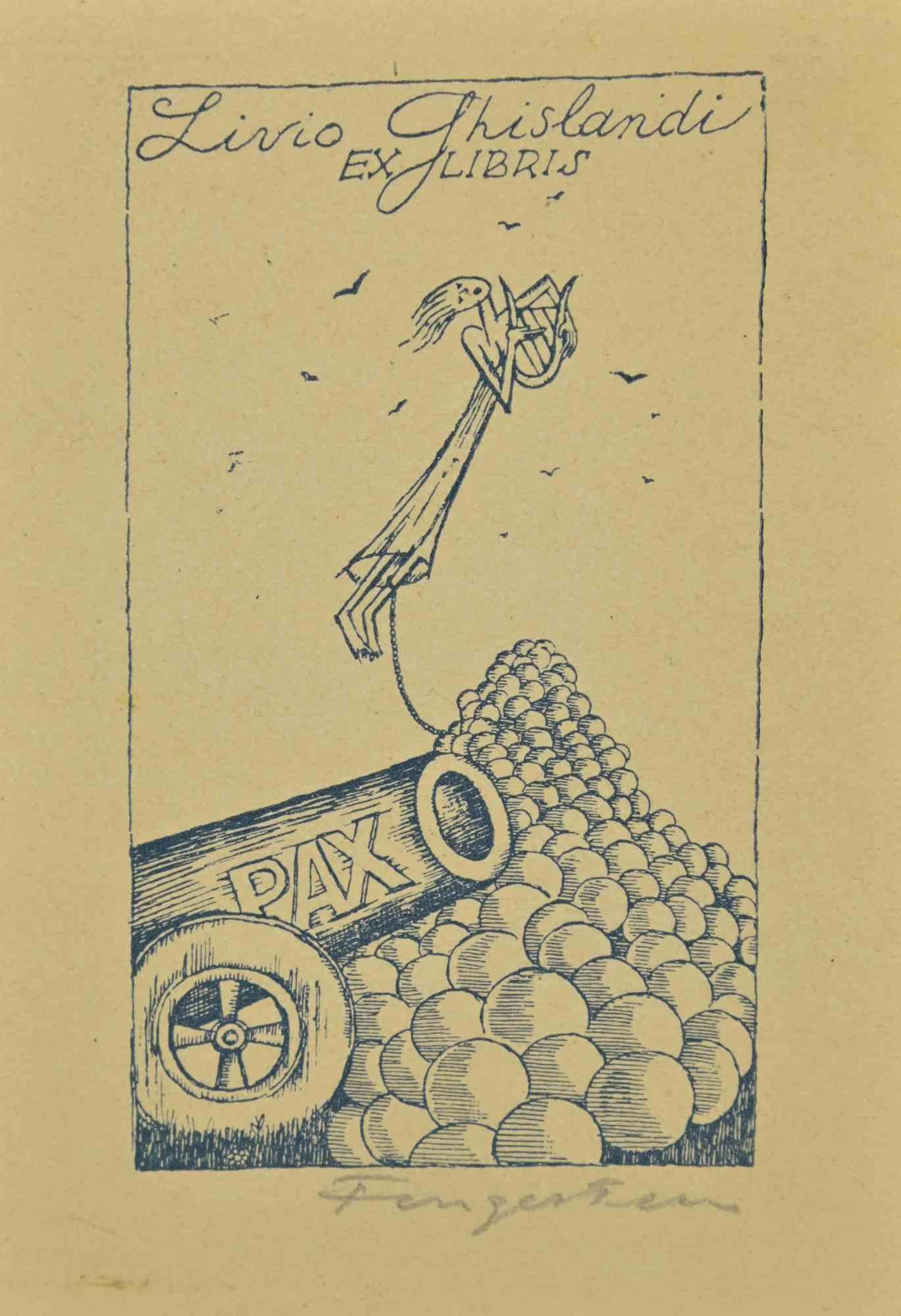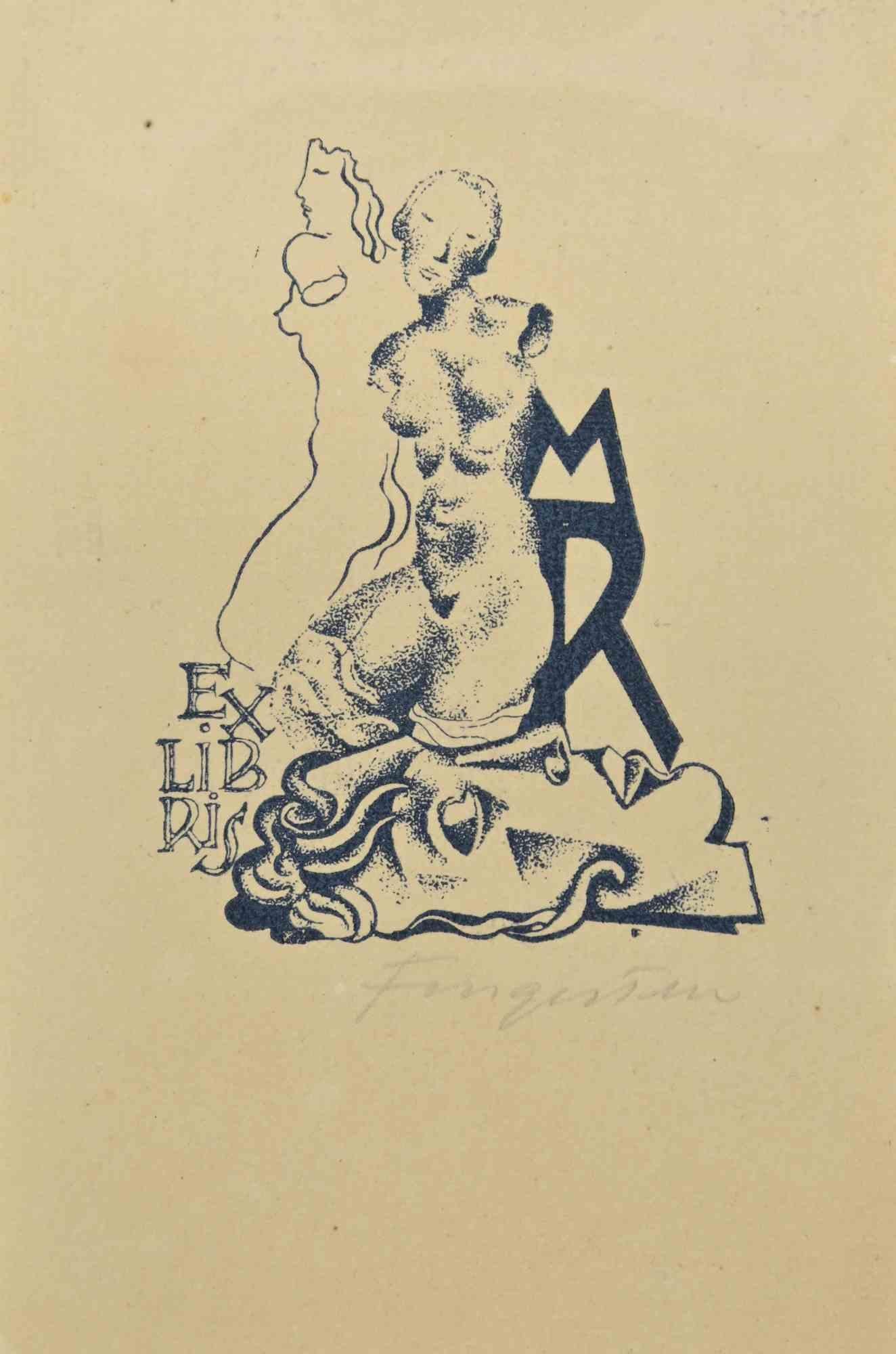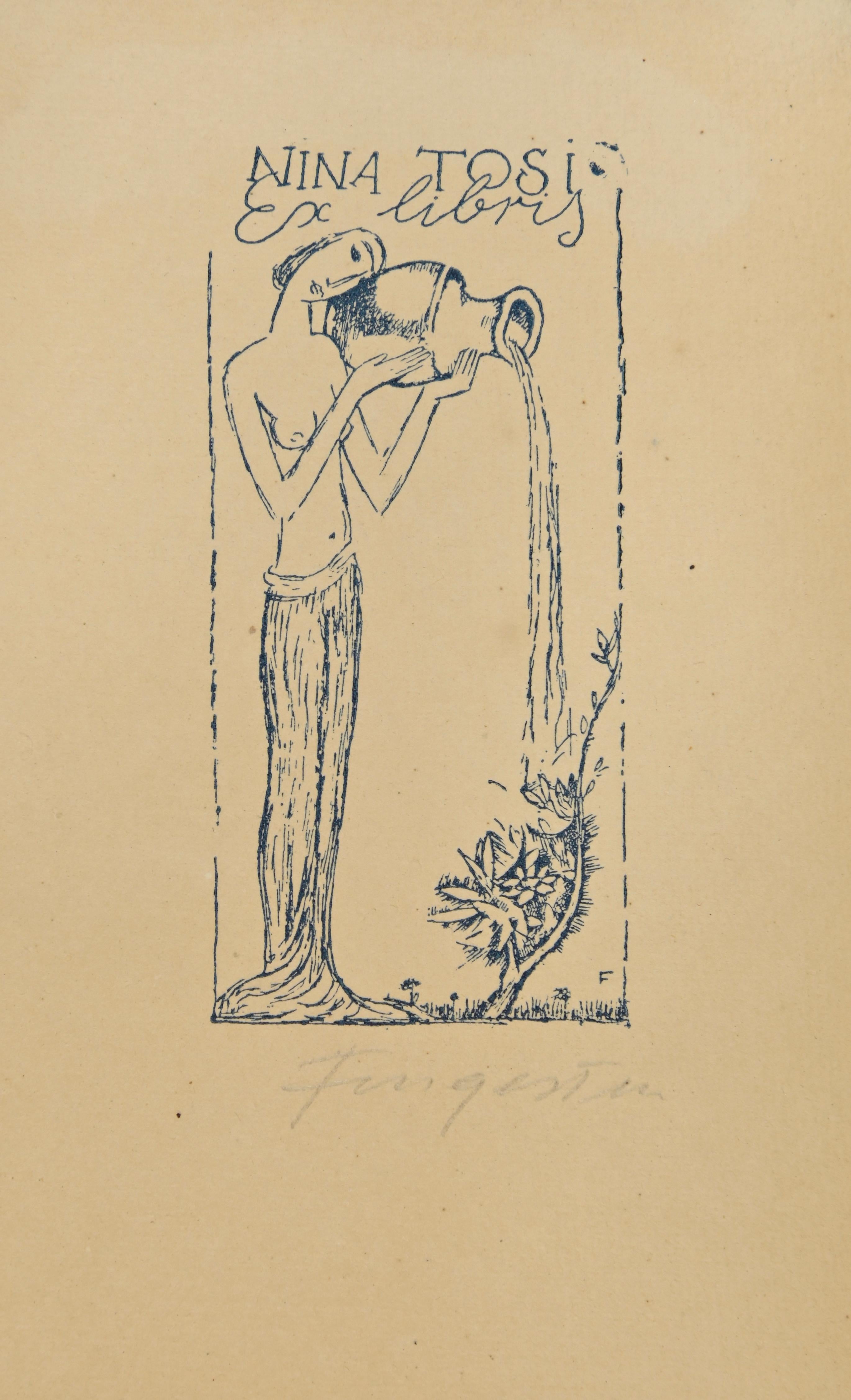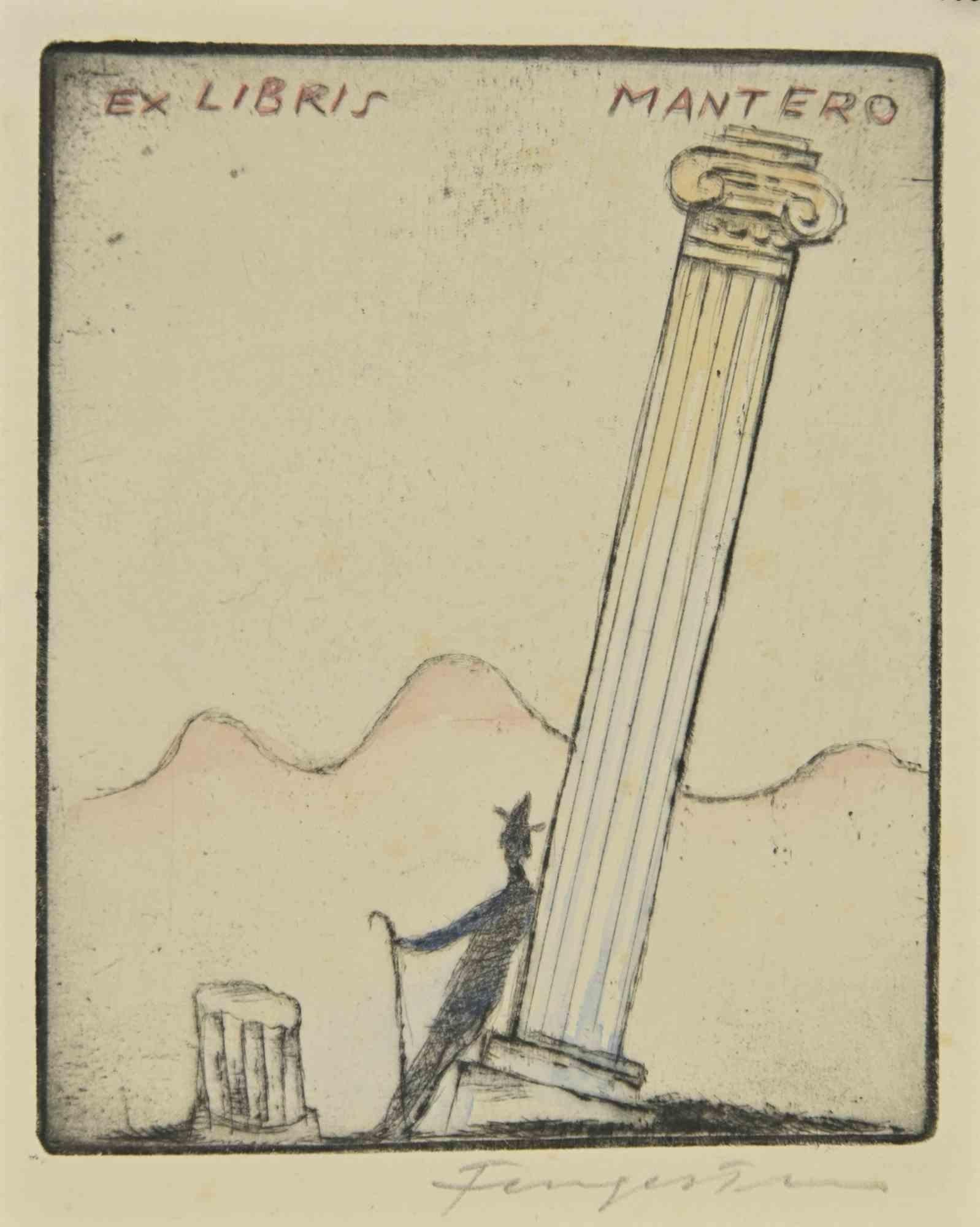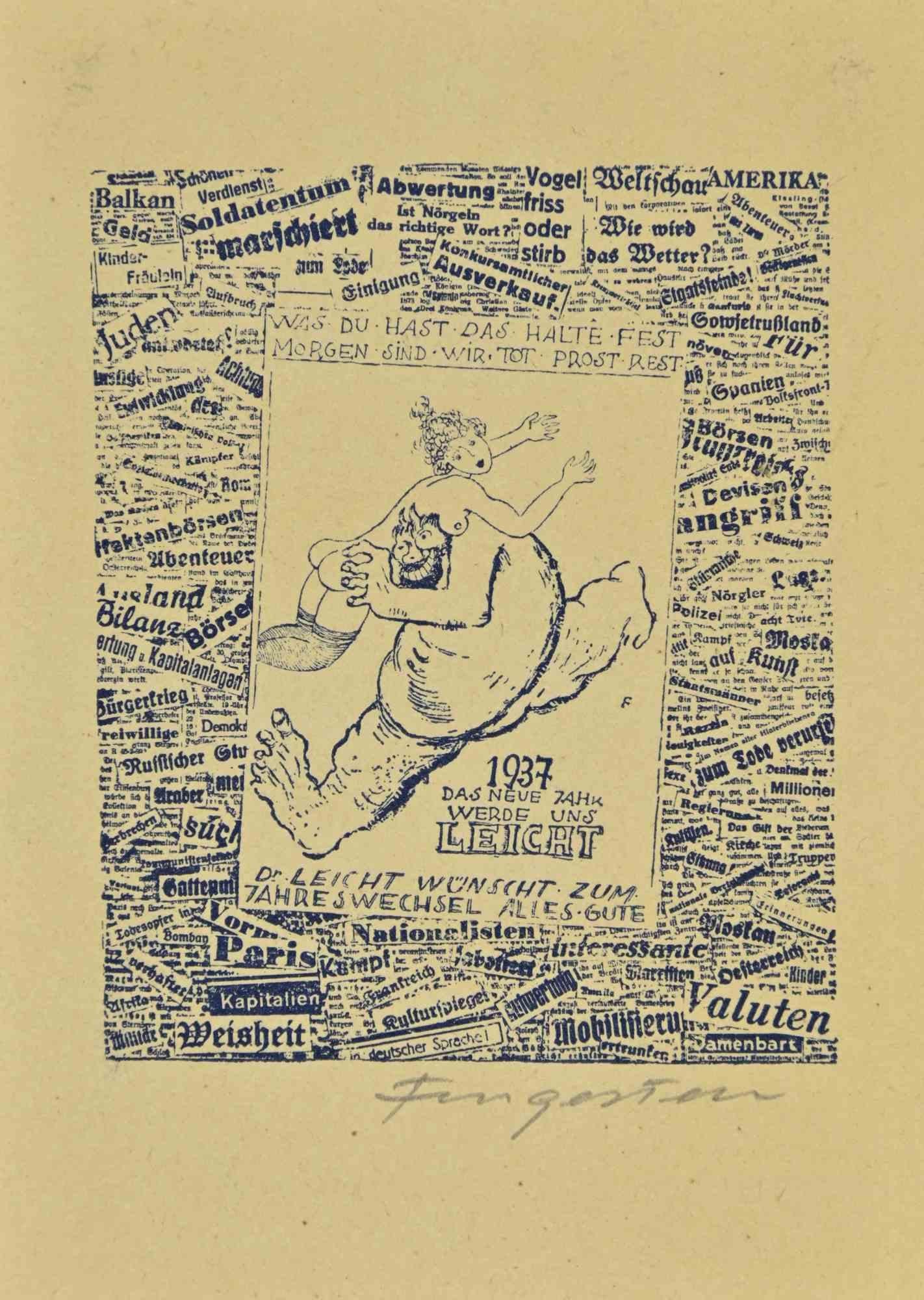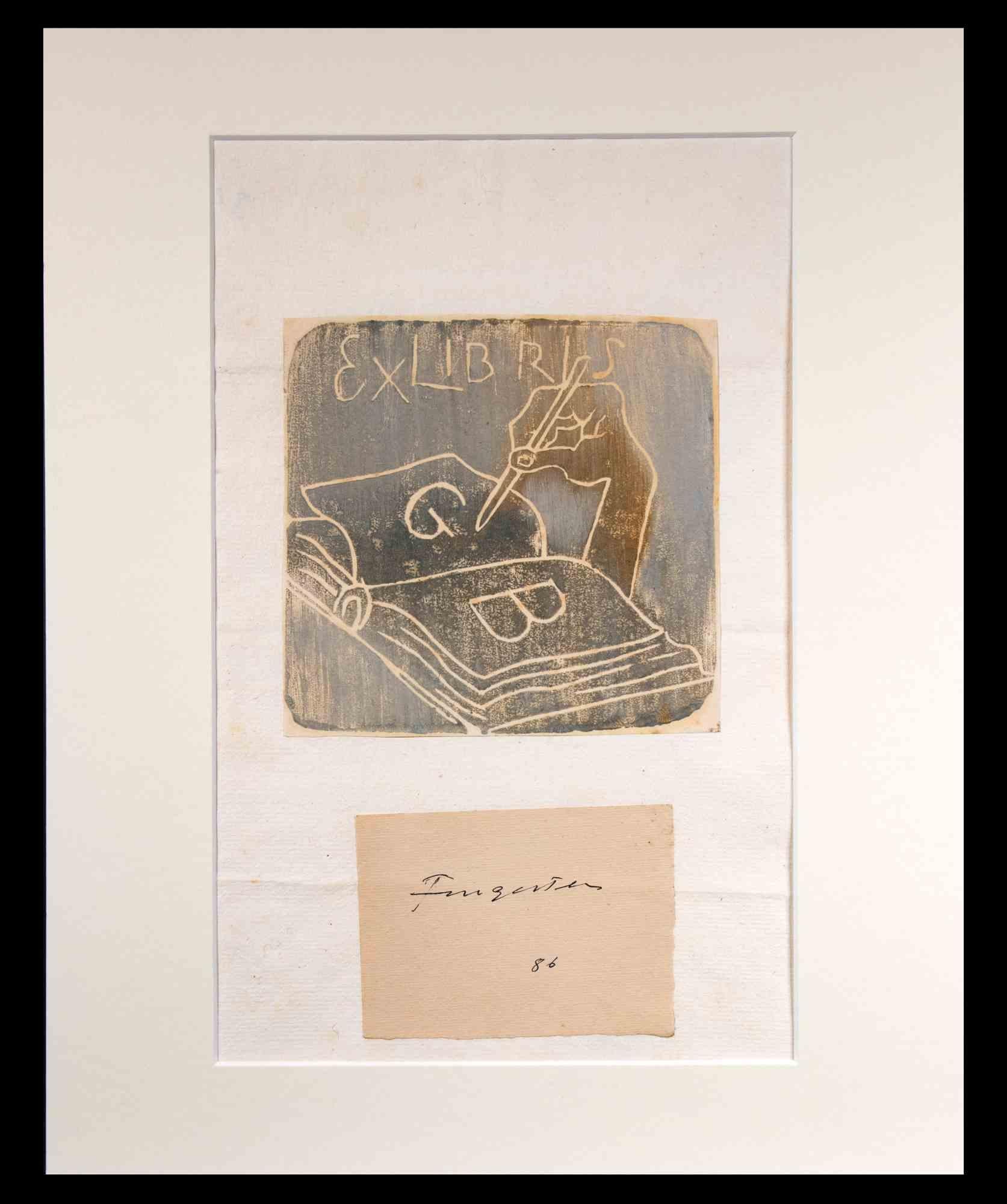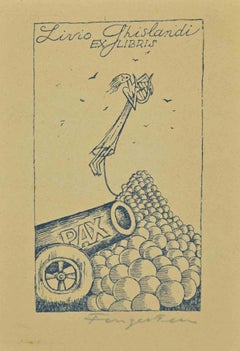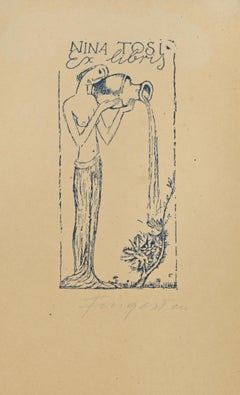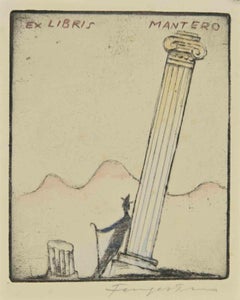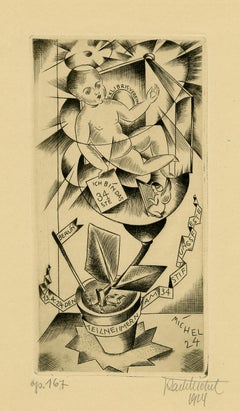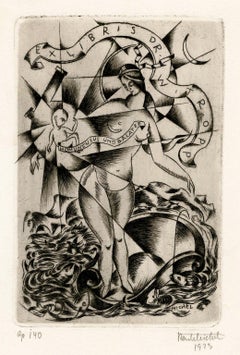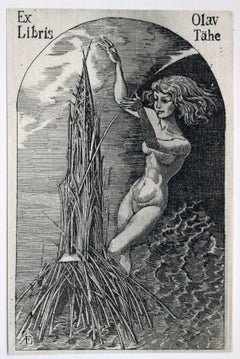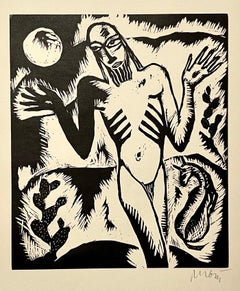Items Similar to Ex Libris - Marco Binnholz - Woodcut by Michel Fingesten - 1930s
Want more images or videos?
Request additional images or videos from the seller
1 of 2
Michel FingestenEx Libris - Marco Binnholz - Woodcut by Michel Fingesten - 1930s1930s
1930s
$455.14
£337.72
€380
CA$635.67
A$689.40
CHF 362.10
MX$8,373.93
NOK 4,531.10
SEK 4,266.28
DKK 2,894.94
About the Item
Ex Libris - Marco Binnholz is a woodcut print created by Michel Fingesten.
Hand Signed on the lower right margin.
Good conditions.
Michel Fingesten (1884 - 1943) was a Czech painter and engraver of Jewish origin. He is considered one of the greatest Ex Libris artists in history. From an Austrian weaver father and a Jewish mother from Trieste. At 16 he studied at the Vienna Academy, together with Oskar Kokoschka. From 1902 to 1906 he wandered around America, and then Australia, before arriving in Palermo in 1907. He went up the peninsula via Trieste and returning to Germany, first settling in Munich in Franz von Stuck's studio, practicing caricature and small format graphics and then in Berlin.
In 1913 he began to record. He returned to Italy in 1935 to visit his maternal relatives from Trieste and remained there because of the racial persecutions to which the Jews in Silesia were subject, settling in Milan. In this period he recorded about 500 exlibris. On 9 October 1940 he was arrested and interned as a foreigner in the camp of Civitella del Tronto and then of Ferramonti, (Cosenza) from November 1941 and will be accused by the Nazis of having painted degenerate art ("Entartete Kunst").
He died on 8 October 1943, after the allies' liberation from the prison camp, due to an infection following a surgical operation carried out at Palazzo Sersale di Cerisano, at that time used as a hospital. His remains rest in the cemetery of the small town of Cosenza's greenhouses. Before this date he executed his last artistic work in Bisignano (Cs), creating a painting on wood depicting the martyrdom of San Bartolomeo, which is still preserved in the homonymous church.
Michel Fingesten, after his liberation from the Ferramonti concentration camp, had relations with the parish priest of Bisignano, don Giuseppe Savaglia, who commissioned the work by giving him a small image as a model. The work was done in a few days, about a week. This painting is important not only as it is the last artistic work of Michel Fingesten but above all because it represents a return to the pictorial art that he had completely abandoned, as in the last years of his life he had dedicated himself only to the realization of Ex Libris.
- Creator:Michel Fingesten (1884 - 1943, Italian)
- Creation Year:1930s
- Dimensions:Height: 4.34 in (11 cm)Width: 3.55 in (9 cm)Depth: 0.04 in (1 mm)
- Medium:
- Movement & Style:
- Period:
- Framing:Framing Options Available
- Condition:Insurance may be requested by customers as additional service, contact us for more information.
- Gallery Location:Roma, IT
- Reference Number:Seller: T-1419191stDibs: LU650312922582
About the Seller
4.9
Platinum Seller
Premium sellers with a 4.7+ rating and 24-hour response times
1stDibs seller since 2017
7,733 sales on 1stDibs
Typical response time: 2 hours
- ShippingRetrieving quote...Shipping from: Grasse, France
- Return Policy
Authenticity Guarantee
In the unlikely event there’s an issue with an item’s authenticity, contact us within 1 year for a full refund. DetailsMoney-Back Guarantee
If your item is not as described, is damaged in transit, or does not arrive, contact us within 7 days for a full refund. Details24-Hour Cancellation
You have a 24-hour grace period in which to reconsider your purchase, with no questions asked.Vetted Professional Sellers
Our world-class sellers must adhere to strict standards for service and quality, maintaining the integrity of our listings.Price-Match Guarantee
If you find that a seller listed the same item for a lower price elsewhere, we’ll match it.Trusted Global Delivery
Our best-in-class carrier network provides specialized shipping options worldwide, including custom delivery.More From This Seller
View AllEx Libris - Livio Ghislandi - Woodcut by Michel Fingesten - 1930s
By Michel Fingesten
Located in Roma, IT
Ex Libris - Livio Ghislandi is a woodcut print created by Michel Fingesten.
Hand Signed on the lower right margin.
Good conditions.
Michel Fingesten (1884 - 1943) was a Czech ...
Category
1930s Symbolist Figurative Prints
Materials
Woodcut
Ex Libris - M.R. - Woodcut by Michel Fingesten - 1930s
By Michel Fingesten
Located in Roma, IT
Ex Libris M.R. is a Woodcut print created by Michel Fingesten.
Hand Signed on the lower right margin.
Very Good condition.
Michel Fingesten (1884 - 1943) was a Czech painter and ...
Category
1930s Symbolist Figurative Prints
Materials
Woodcut
Ex Libris - Nina Tosi - Woodcut by Michel Fingesten - 1930s
By Michel Fingesten
Located in Roma, IT
Ex Libris - Nina Tosi is a woodcut print created by Michel Fingesten.
Hand Signed on the lower right margin.
Good conditions.
Michel Fingesten (1884 - 1943) was a Czech painter a...
Category
1930s Symbolist Figurative Prints
Materials
Woodcut
Ex Libris - Mantero - Woodcut by Michel Fingesten - 1930s
By Michel Fingesten
Located in Roma, IT
Ex Libris - Mantero is a Woodcut print created by Michel Fingesten.
Hand Signed on the lower right margin.
Very Good condition.
Michel Fingesten (1884 - 1943) was a Czech painter...
Category
1930s Symbolist Figurative Prints
Materials
Woodcut
Ex Libris - Woodcut by Michel Fingesten - 1930s
By Michel Fingesten
Located in Roma, IT
Ex Libris is a woodcut print created by Michel Fingesten in 1937.
Hand Signed on the lower right margin.
Good conditions.
Michel Fingesten (1884 - 1943) was a Czech painter an...
Category
1930s Symbolist Figurative Prints
Materials
Woodcut
Ex Libris G.B. - Woodcut by Michel Fingesten - 1937
By Michel Fingesten
Located in Roma, IT
Ex Libris G.B. is a woodcut print by Michel Fingesten, in 1937.
Hand signed , included a white cardboard passpartout (30x24 cm).
In excellent conditions: As good as new.
Michel Fingesten (1884 - 1943) was a Czech painter and engraver of Jewish origin. He is considered one of the greatest Ex Libris artists in history. From an Austrian weaver father and a Jewish mother from Trieste. At 16 he studied at the Vienna Academy, together with Oskar Kokoschka. From 1902 to 1906 he wandered around America, and then Australia, before arriving in Palermo in 1907. He went up the peninsula via Trieste and returning to Germany, first settling in Munich in Franz von Stuck's studio, practicing caricature and small format graphics and then in Berlin.
In 1913 he began to record. He returned to Italy in 1935 to visit his maternal relatives from Trieste and remained there because of the racial persecutions to which the Jews in Silesia were subject, settling in Milan. In this period he recorded about 500 exlibris. On 9 October 1940 he was arrested and interned as a foreigner in the camp of Civitella del Tronto and then of Ferramonti, (Cosenza) from November 1941 and will be accused by the Nazis of having painted degenerate art ("Entartete Kunst...
Category
Early 20th Century Symbolist Figurative Prints
Materials
Woodcut
You May Also Like
'Ex Libris Verein' — 1920s German Expressionism
By Karl Michel
Located in Myrtle Beach, SC
Karl Michel, 'Ex Libris Verein' (New Year's Ex Libris Club Announcement), etching, 1924. Signed, dated, and numbered 'op. 167' in pencil. Signed and dated in...
Category
1920s Expressionist Figurative Prints
Materials
Etching
'Ex Libris Dr. Witropp' — German Expressionism
By Karl Michel
Located in Myrtle Beach, SC
Karl Michel, 'Ex Libris Dr. Witropp - Homunculus und Galatee', etching, 1923, edition not stated. Signed, dated, and numbered 'Op. 140' (the artist's inventory number) in pencil. Si...
Category
1920s Expressionist Figurative Prints
Materials
Etching
Ex libris. Paper, woodcut, 11x7cm
Located in Riga, LV
Ex libris Olav Tähe
Paper, woodcut, 11x7cm
Category
1990s Jugendstil Nude Prints
Materials
Paper, Woodcut
$172 Sale Price
20% Off
Rare 1923 Cubist Reuven Rubin Woodcut Woodblock Kabbalah Print Israeli Judaica
By Reuven Rubin
Located in Surfside, FL
This is from the original first edition 1923 printing. there was a much later edition done after these originals.
These are individually hand signed in pencil by artist as issued.
This listing is for the one print. the other documentation is included here for provenance and is not included in this listing.
The various images inspired by the Jewish Mysticism and rabbis and mystics of jerusalem and Kabbalah is holy, dramatic and optimistic Rubin succeeded to evoke the spirit of life in Israel in those early days.
They are done in a modern art style influenced by German Expressionism, particularly, Ernst Barlach, Ernst Ludwig Kirchner, and Franz Marc, as introduced to Israel by Jakob Steinhardt, Hermann Struck and Joseph Budko.
Reuven Rubin 1893 -1974 was a Romanian-born Israeli painter and Israel's first ambassador to Romania.
Rubin Zelicovich (later Reuven Rubin) was born in Galati to a poor Romanian Jewish Hasidic family. He was the eighth of 13 children. In 1912, he left for Ottoman-ruled Palestine to study art at Bezalel Academy of Art and Design in Jerusalem. Finding himself at odds with the artistic views of the Academy's teachers, he left for Paris, France, in 1913 to pursue his studies at the École Nationale Supérieure des Beaux-Arts. He was of the well known Jewish artists in Paris along with Marc Chagall and Chaim Soutine,
At the outbreak of World War I, he was returned to Romania, where he spent the war years.
In 1921, he traveled to the United States with his friend and fellow artist, Arthur Kolnik. In New York City, the two met artist Alfred Stieglitz, who was instrumental in organizing their first American show at the Anderson Gallery. Following the exhibition, in 1922, they both returned to Europe. In 1923, Rubin emigrated to Mandate Palestine.
Rubin met his wife, Esther, in 1928, aboard a passenger ship to Palestine on his return from a show in New York. She was a Bronx girl who had won a trip to Palestine in a Young Judaea competition. He died in 1974.
Part of the early generation of artists in Israel, Joseph Zaritsky, Arieh Lubin, Reuven Rubin, Sionah Tagger, Pinchas Litvinovsky, Mordecai Ardon, Yitzhak Katz, and Baruch Agadati; These painters depicted the country’s landscapes in the 1920s rebelled against the Bezalel school of Boris Schatz. They sought current styles in Europe that would help portray their own country’s landscape, in keeping with the spirit of the time. Rubin’s Cezannesque landscapes from the 1920s were defined by both a modern and a naive style, portraying the landscape and inhabitants of Israel in a sensitive fashion. His landscape paintings in particular paid special detail to a spiritual, translucent light. His early work bore the influences of Futurism, Vorticism, Cubism and Surrealism.
In Palestine, he became one of the founders of the new Eretz-Yisrael style. Recurring themes in his work were the bible, the prophet, the biblical landscape, folklore and folk art, people, including Yemenite, Hasidic Jews and Arabs. Many of his paintings are sun-bathed depictions of Jerusalem and the Galilee. Rubin might have been influenced by the work of Henri Rousseau whose naice style combined with Eastern nuances, as well as with the neo-Byzantine art to which Rubin had been exposed in his native Romania. In accordance with his integrative style, he signed his works with his first name in Hebrew and his surname in Roman letters.
In 1924, he was the first artist to hold a solo exhibition at the Tower of David, in Jerusalem (later exhibited in Tel Aviv at Gymnasia Herzliya). That year he was elected chairman of the Association of Painters and Sculptors of Palestine. From the 1930s onwards, Rubin designed backdrops for Habima Theater, the Ohel Theater and other theaters.
His biography, published in 1969, is titled My Life - My Art. He died in Tel Aviv in October 1974, after having bequeathed his home on 14 Bialik Street and a core collection of his paintings to the city of Tel Aviv. The Rubin Museum opened in 1983. The director and curator of the museum is his daughter-in-law, Carmela Rubin. Rubin's paintings are now increasingly sought after. At a Sotheby's auction in New York in 2007, his work accounted for six of the ten top lots. Along with Yaacov Agam and Menashe Kadishman he is among Israel's best known artists internationally. Education
1912 Bezalel Academy of Arts and Design, Jerusalem
1913-14 École des Beaux Arts, Paris and Académie Colarossi, Paris
Select Group Exhibitions
Eged - Palestine Painters Group Eged - Palestine Painters Group, Allenby Street, Tel Aviv 1929
Artists: Chana Orloff, Abraham Melnikoff, Rubin, Reuven Nahum Gutman, Sionah Tagger,Arieh Allweil,
Jewish Artists Association, Levant Fair, Tel Aviv, 1929
Artists: Ludwig Blum,Eliyahu Sigad, Shmuel Ovadyahu, Itzhak Frenel Frenkel,Ozer Shabat, Menahem Shemi...
Category
1920s Abstract Figurative Prints
Materials
Woodcut
Eva und die Schlange, 1923: Avant-Garde Lithograph by Nathan Altmann
Located in Langweer, NL
"Eva und die Schlange" (Eve and the Snake) by Nathan Altman is anintriguing lithograph from the "Jüdische Graphik" series produced in 1923. This artwork features a compelling and symbolically rich depiction of Eve entwined with the snake, set against the same burnished gold background that characterizes other prints from this series. The use of black and white lithography enhances the dramatic interplay between the figures, highlighting themes of temptation and knowledge that are central to the Biblical story of Eve.
In this print, Altman's avant-garde sensibilities are evident in the stylization of the figures and the expressive, almost abstract forms of the snake and foliage. The inclusion of Hebrew text further anchors the piece within its Jewish cultural context, possibly adding layers of interpretation related to wisdom, sin, and redemption.
As with the other prints from this series, the limited edition of only 250 copies increases its rarity and value. Altman's work not only captures significant biblical narratives but also reflects the broader themes of cultural identity and modernist experimentation in the early 20th century. This print serves as a fascinating example of how traditional stories are reinterpreted through modernist artistic lenses, making it a valuable piece for collectors and admirers of Jewish and avant-garde art.
Altmann’s choice of a burnished gold background not only enriches the visual impact but also elevates the symbolic elements, giving the artwork a solemn and revered quality. This specific piece, like others from the series, was produced in Berlin by the publisher "Petropolis," reflecting the vibrant Jewish artistic community that existed in pre-war Europe. Altmann’s work, especially given his background as a Jewish artist in Soviet Russia, often navigated between his cultural identity and the broader avant-garde movements, making each of his pieces historically and artistically significant. This print, considering its rarity and the mystery surrounding the number of surviving copies, is an exceptional representation of Jewish cultural history intertwined with early 20th-century art movements.
Nathan Altman was an influential figure in the Russian and Soviet avant-garde movement. Born in 1889 in Vinnytsia, Ukraine, he studied at the Odessa Art School, later moving to Paris to further his education at the Academie de la Grande Chaumiere. Altman's style evolved over the years, showing strong influences from Cubism and Futurism, which are evident in his approach to stage design and book illustration as well.
Altman's contributions extend beyond visual arts; he was also notable for his set designs for Jewish theaters...
Category
Vintage 1920s Prints
Materials
Paper
$1,031 Sale Price
30% Off
1943 Israeli German Expressionist Woodcut Print Vintage Woodblock Bezalel School
By Jacob Pins
Located in Surfside, FL
Jacob Otto Pins (17 January 1917 – 4 December 2005) was a German-born Israeli woodcut artist and art collector, particularly of Japanese prints and paintings.
Jacob Pins was born in Höxter, Germany, the son of Dr Leo Pins, a veterinarian, and his wife Ida Lipper. He immigrated to Palestine in 1936 to study art. His father tried to discourage him from becoming an artist for financial reasons.
Pins' younger brother, Rudolph, (1920-2016) moved to the United States in 1934. His father was sent to Buchenwald. In July 1944, both parents died in the Riga ghetto.
Pins first lived on a kibbutz, which was disbanded in 1941. He moved to Jerusalem and studied woodcut and linocut under woodcut master and painter Jacob Steinhardt, also a German immigrant, at his small private school. He lived in poverty in a tiny room, subsisting on a meagre diet. He continued his studies at the new Bezalel Academy of Art and Design.
Pins was married to Elsa, the subject of a number of his prints. They had no children.
Pins bought his first Oriental print in 1945, and acquired a house on Ethiopia Street, opposite the Ethiopian church, where he lived for the rest of his life. He continued collecting until his death and was one of Israel's foremost art collectors. His book on Japanese Pillar Prints, Hashira-e is the definitive work on the subject.
Pins died in Jerusalem in December 2005.
Pins' artwork was heavily influenced by German expressionism and traditional Japanese wood block printing. From 1956 to 1977, he taught at Israel's leading art schools, most notably Bezalel, where he later became a professor. He was known as a demanding teacher, emphasizing strong technical skills and discipline.
In the 1950s, Pins helped to found the Jerusalem Artists' House, a centre for the city's artists to meet and exhibit.
Legacy
Pins' extensive collection of Japanese woodprints...
Category
1940s Expressionist Mixed Media
Materials
Woodcut
More Ways To Browse
Metropolitan Opera Poster
Metropolitan Opera Vintage Posters
Mexican Woodcut
Michelangelo Etching
Murakami Flower Ball
New Orleans Jazz Art
Original Toulouse Lautrec Lithograph
Peter Sager
Picasso Saltimbanques
Picture Of Dorian Gray
Pierre Casanova
Police Mugshot
Privat Livemont
Rene Portocarrero
Renoir Drawings
Royal Albert Old Country Roses
Salvador Dali 1967
Salvador Dali Mythology
